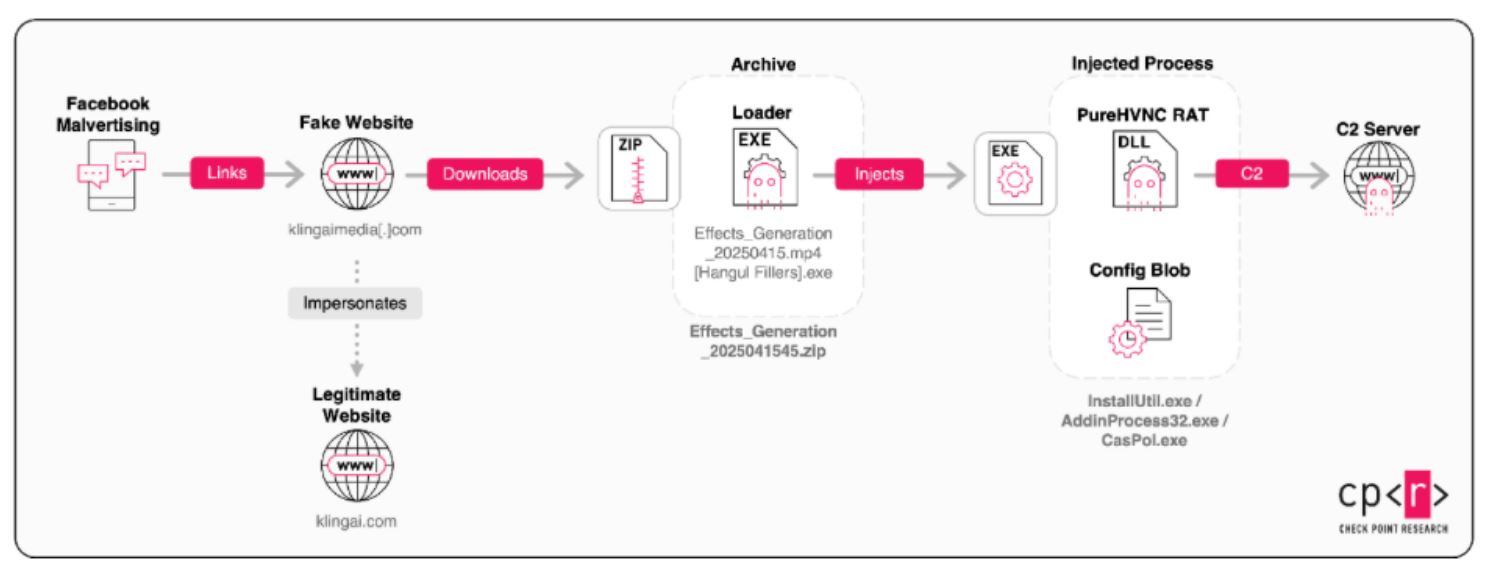Exploiting the AI Boom: Check Point Breaks Down How Threat Actors Are Targeting Trust in Generative Platforms
Check Point's Threat Emulation and Harmony Endpoint Offer Robust Protection Against the Techniques and Threats Outlined Below

As generative AI (Artificial Intelligence) continues to capture global attention, threat actors are quick to exploit AI’s capabilities and popularity. From deepfake scams to impersonation attacks, the rising trust in AI-powered platforms has created new openings for cyber criminals. In early 2025, Check Point Research began tracking a sophisticated threat campaign that capitalised on this trend, specifically by impersonating Kling AI, a widely used image and video synthesis tool with over six million users.
This campaign, propagated through false Facebook advertisements and spoofed pages, ultimately directed users to a counterfeit website designed to deliver a malicious payload.
From Fake Ads to Fake Downloads
The attack begins with fake advertisements on social media. Since early 2025, the Check Point team has identified around 70 sponsored posts that falsely promote the popular AI tool Kling AI. These ads come from convincing but fraudulent Facebook pages designed to look like the real company.

Clicking on one of these ads leads users to a fake website that closely mimics Kling AI’s actual interface. Just like the real tool, the site invites users to upload images and click a “Generate” button to see AI-powered results. However, instead of delivering an image or video, the site offers a download—one that appears to be an archive file containing a new AI-generated media file.

The downloaded file is made to look like a harmless image, complete with a name like “Generated_Image_2025.jpg” and even a familiar image icon. However, behind this seemingly harmless appearance lies something dangerous: the file is a disguised program intended to compromise the user’s system. This technique—known as filename masquerading—is a common tactic used by threat actors to trick users into launching malicious software.
Once opened, the program quietly installs itself, ensures it can restart automatically every time the computer is turned on. It also checks for any signs that it is being watched or analysed by cybersecurity tools and tries to avoid detection.
Stage 2: Silent Takeover with Remote Access Tools
After the initial fake file is opened, a second, more serious threat is activated. This stage installs called a Remote Access Trojan (RAT), a malware that allows attackers to take control of the victim’s computer from a distance.
Each version of this tool is slightly altered to avoid detection, but all include a hidden configuration file that connects back to the attackers’ server. These files also contain campaign names like “Kling AI 25/03/2025” or “Kling AI Test Startup,” suggesting ongoing testing and updates by the threat actors.
Once in place, the malware begins monitoring the system—especially web browsers and extensions that store passwords or other sensitive data—giving attackers the ability to steal personal information and maintain long-term access.

Check Point Uncovers a Familiar Playbook: Tracing the Campaign
While the exact identity of the attackers remains unknown, evidence strongly suggests links to Vietnamese threat actors. Facebook-based scams and malware campaigns are a known tactic among groups from the region—especially those focused on stealing personal data.
In this case, Check Point analysis revealed multiple clues pointing in that direction. Similar campaigns themed around AI tools have previously contained Vietnamese-language terms within the malware code. Consistent with that pattern, we found several references—such as debug messages—in Vietnamese in this latest campaign as well.
These findings align with broader trends observed by other security researchers investigating similar Facebook malvertising efforts.
Defending Against the New Face of AI-Themed Threats
As generative AI tools grow in popularity, cybercriminals are finding new ways to exploit that trust. This campaign, which impersonated Kling AI through fake ads and deceptive websites, demonstrates how threat actors are combining social engineering with advanced malware to gain access to users’ systems and personal data.
With tactics ranging from file masquerading to remote access and data theft, and signs pointing to Vietnamese threat groups, this operation fits into a broader trend of increasingly targeted and sophisticated social media-based attacks.
For a comprehensive understanding of the impersonation attack, read Check Point Research’s publication here.




